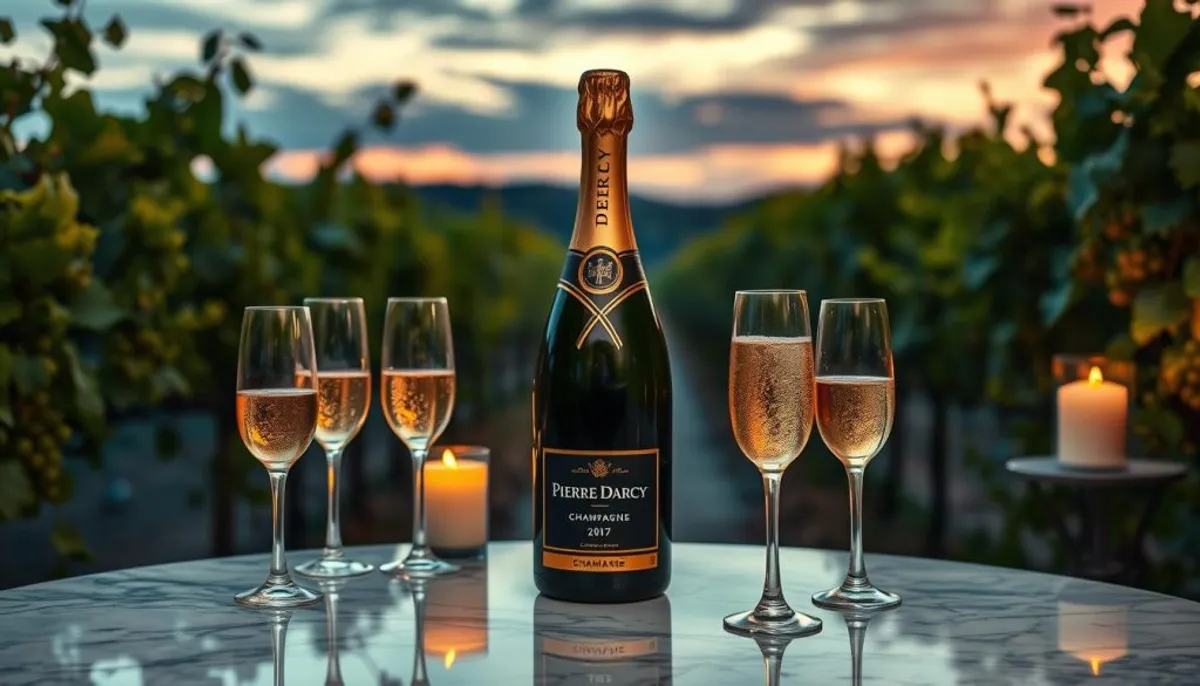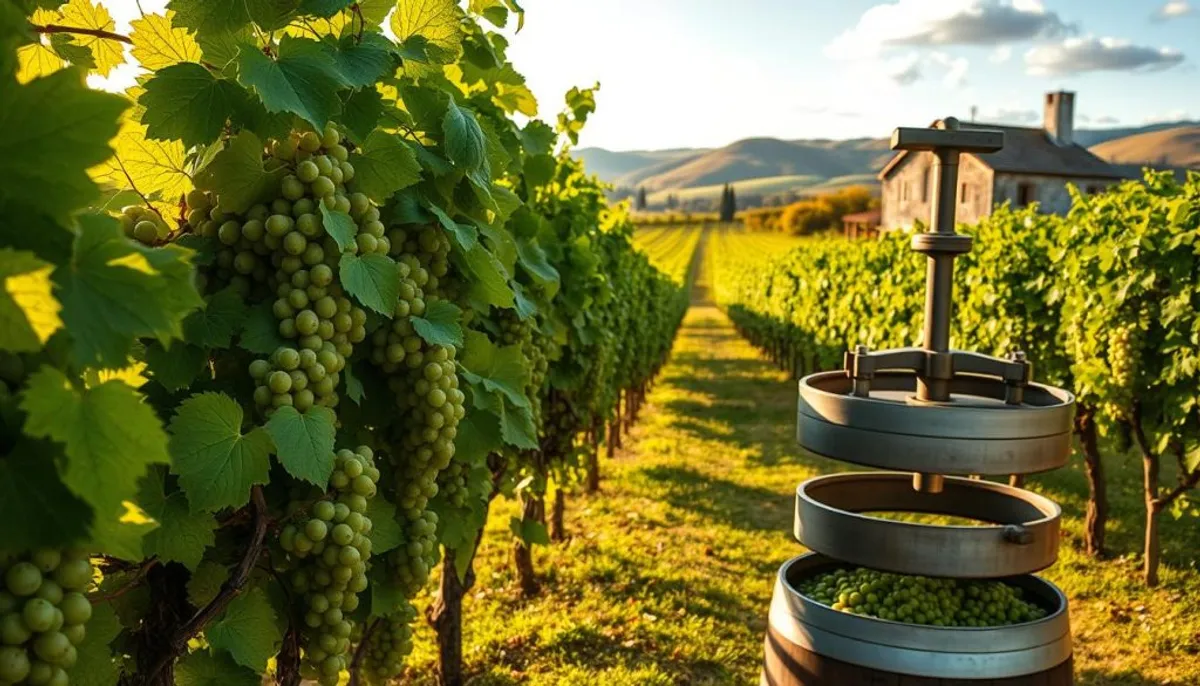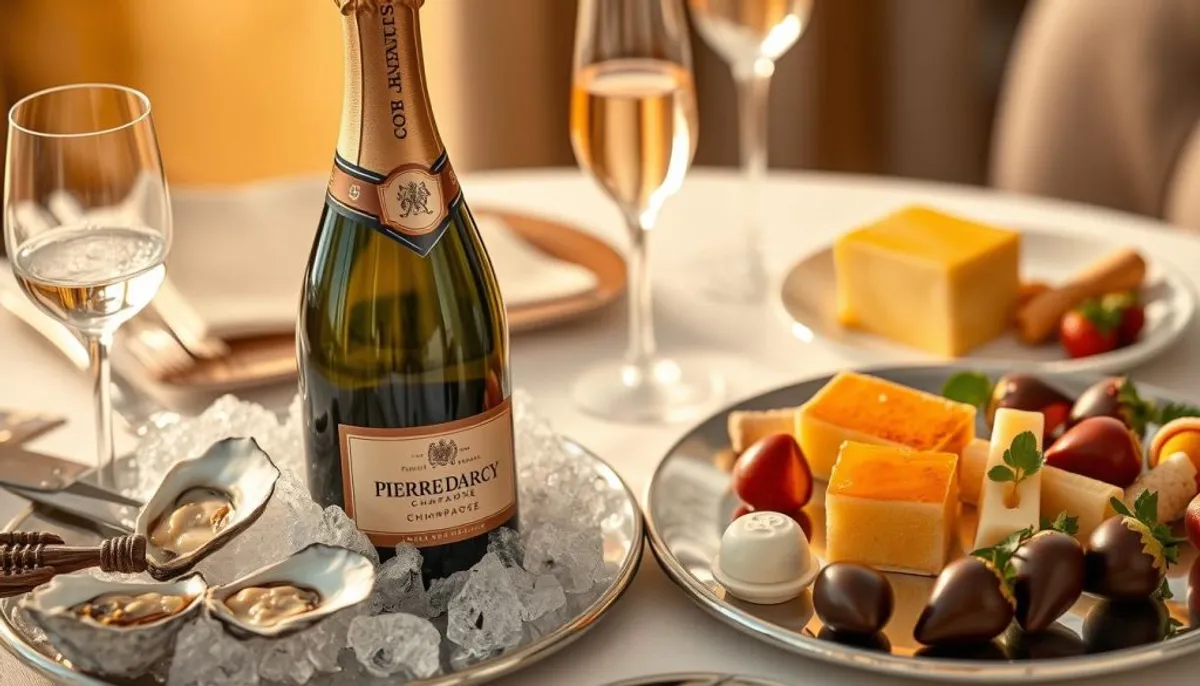Pierre Darcy Champagne epitomizes French luxury sparkling wine, originating from the esteemed Champagne region. This exquisite bubbly has won the hearts of wine aficionados globally. With an average rating of 3.7 from 1,879 Vivino reviews, Pierre Darcy has solidified its reputation as a premier choice for those desiring French elegance.
The winery, situated at the heart of Champagne, France, produces a variety of sparkling wines that reflect the region’s rich heritage. Pierre Darcy’s dedication to quality has cemented its status as a highly sought-after brand in the global Champagne export market. Enthusiasts can secure personalized quotes for this luxurious French Champagne through champagne-export.com.

Priced at €28, Pierre Darcy Champagne offers an affordable gateway into the realm of luxury sparkling wines. With an alcohol content of 12% ABV, it delivers 9.0 UK units per bottle. This aligns with the UK Chief Medical Officers’ guidelines, recommending 3-4 units for men and 2-3 units for women daily.
Compared to other sparkling wines, Pierre Darcy stands out. While Asda’s Pierre Darcys Brut Champagne is available for $9.99, and Aldi’s Blanc de Noirs Champagne Brut costs £16.99, Pierre Darcy strikes a balance between quality and affordability. It’s important to note that the legal drinking age for this French Champagne is 18 years.
Key Takeaways
- Pierre Darcy Champagne is a French luxury sparkling wine from the Champagne region
- The brand has an average rating of 3.7 based on 1,879 Vivino reviews
- Pierre Darcy offers a variety of sparkling wines for global export
- Priced at €28, it provides an accessible entry into luxury Champagne
- The Champagne has 12% ABV and contains 9.0 UK units per bottle
- Pierre Darcy competes well with other sparkling wines in terms of quality and value
The Heritage of Champagne Region: From Romans to Modern Day
The Champagne history is a tapestry of centuries, woven with the threads of winemaking tradition. This region’s transformation from ancient vineyards to a global sparkling wine icon is a narrative of innovation and unwavering dedication.
Roman Origins in Reims: 5th Century Beginnings
In the 5th century, Romans planted the first vineyards in Reims, setting the stage for Champagne’s illustrious future. These early endeavors in Reims laid the groundwork for a wine region that would eventually earn international acclaim.
Evolution of Sparkling Wine Production
The journey of sparkling wine production was fraught with obstacles. Initially dubbed “the devil’s wine” due to its tendency to burst bottles, Champagne faced numerous challenges. Yet, through advancements in bottle and cork technology, the path to modern production was cleared.
The Benedictine Monks’ Accidental Discovery
In the 16th century, a chance occurrence by Benedictine monks led to the creation of sparkling Champagne. This accidental discovery was a pivotal moment, marking a significant shift in the region’s winemaking trajectory and cementing the drink’s status as an iconic beverage.
| Era | Key Development |
|---|---|
| 5th Century | Roman establishment of Reims vineyards |
| 16th Century | Accidental discovery of sparkling Champagne |
| 17th-18th Centuries | Improvements in bottle and cork technology |
| Modern Era | Refined production methods and global recognition |
Today, Champagne is synonymous with celebration and luxury, its production honed over centuries. The region’s relentless pursuit of quality and tradition continues to influence the sparkling wine industry globally.
Understanding Pierre Darcy Champagne
The Pierre Darcy brand is a beacon in the realm of French sparkling wine. It is renowned for its exquisite bubbly, embodying the essence of the region. This Champagne production house has carved a niche for itself in the industry, setting it apart from others. The art of champagne connoisseurship is evident in every bottle they produce.
Brand Overview and Reputation
Pierre Darcy has solidified its reputation among esteemed Champagne producers. It offers a variety of styles, including the sought-after Blanc de Noirs Réserve Brut. In Ireland, its Brut Champagne is available at €19.99 at SuperValu, making it a luxury within reach for many wine aficionados.
Production Methods and Standards
Pierre Darcy adheres to traditional Champagne production techniques. The brand upholds rigorous appellation standards, guaranteeing each bottle’s quality. Like other Champagnes, Pierre Darcy’s products generally have an alcohol content of 12-12.5% by volume.
Distinctive Characteristics
Pierre Darcy Champagne is a blend of Chardonnay, Pinot Noir, and Pinot Meunier grapes. This blend creates a balanced flavor profile, appealing to both newcomers and seasoned Champagne enthusiasts. The brand’s dedication to quality is evident in its pricing, offering a luxurious experience without the hefty cost.
| Champagne Brand | Price (€) |
|---|---|
| Pierre Darcy Brut | 19.99 |
| Lidl Comte de Brismand Brut Reserve | 17.99 |
| Tesco Finest Premier Cru Brut | 27.99 |
| Aldi Veuve Monsigny Premier Cru | 22.99 |
The Art of Champagne Making
The Champagne production process is a harmonious fusion of tradition and scientific precision. It commences with the meticulous selection of grapes, predominantly Chardonnay, Pinot Noir, and Pinot Meunier. These grapes undergo primary fermentation, converting their sugars into alcohol. The true alchemy, though, occurs during the secondary fermentation.
Following the bottling of the base wine, a blend of sugar and yeast, known as the liqueur de tirage, is added. This initiates the secondary fermentation within the bottle. As the yeast metabolizes the sugar, it generates alcohol and carbon dioxide. The carbon dioxide, trapped within the sealed bottle, dissolves into the wine, crafting Champagne’s distinctive effervescence.

This method, referred to as méthode champenoise, is time-consuming. Non-vintage Champagnes mature for at least 15 months, whereas vintage varieties require a minimum of 36 months. This extended aging period allows the wine to refine its complex flavors and aromas. Vintage Champagnes, with their longer aging, showcase more nuanced flavor profiles.
The final stage involves the removal of dead yeast cells and the addition of a dosage of sugar to adjust the acidity. This culminates in a sparkling wine that reflects the terroir of Champagne and the expertise of its creators. Each glass of Champagne, along with fine french wines, is a celebration of this intricate craftsmanship, offering a unique sensory journey that has enthralled wine aficionados for generations.
Pierre Darcy’s Grape Varieties
Pierre Darcy Champagne crafts its exquisite sparkling wines using three primary Champagne grape varieties. Each variety brings unique qualities to the blend, resulting in a harmonious and complex wine.
Pinot Noir: The Bold Foundation
Pinot Noir forms the backbone of Pierre Darcy Champagne. This red grape contributes body and structure to the wine. Pinot Noir-based wines often display low tannins and a medium body with fruity notes. In Pierre Darcy’s vineyards, Pinot Noir accounts for 6.7% of the planted area.
Chardonnay: Adding Elegance
Chardonnay is the dominant grape in Pierre Darcy’s vineyards, covering 93% of the area. This white grape adds elegance and finesse to the Champagne. Chardonnay brings crisp acidity and delicate floral aromas, enhancing the wine’s complexity.
Pinot Meunier: The Final Touch
Pinot Meunier, though less prevalent at 0.6% of the vineyard area, plays a crucial role. This grape variety enhances fruitiness and adds a round mouthfeel to the Champagne. It complements the other varieties, creating a well-balanced blend.
The careful combination of these Champagne grape varieties results in Pierre Darcy’s distinctive flavor profile. The brand’s Brut Champagne, priced competitively at an average of 30.5 €/bottle, showcases the harmonious blend of these grapes.
Tasting Profile and Characteristics
Pierre Darcy Champagne presents a sensory delight. We’ll dive into its unique tasting profile and characteristics, from its visual appeal to its flavor components.
Visual Appearance and Bubbles
This champagne boasts a pale gold hue, evoking sunlight on crystal. Fine, persistent bubbles ascend elegantly, forming a refined mousse that caresses the palate.
Aroma Profile
The champagne’s tasting notes unveil fresh, delicate aromas. Citrusy lemon and crisp apple scents blend, crafting an inviting bouquet that heralds a refreshing journey.
Flavor Components
Pierre Darcy Champagne’s palate offers a harmonious flavor profile. It begins with a vibrant citrus burst, complemented by subtle apple undertones. Balanced acidity provides structure, culminating in a clean, refreshing finish.
| Characteristic | Description |
|---|---|
| Color | Pale gold |
| Aroma | Fresh lemon and apple |
| Taste | Citrus burst, apple undertones |
| Finish | Clean and refreshing |
| ABV | 12% |
Priced at €28 per bottle, Pierre Darcy Champagne represents excellent value for its quality. With 9.0 UK units per bottle and a serving size of 1.5 UK units per 125ml glass, it’s ideal for celebratory toasts or fine cuisine pairings.
Food Pairing Recommendations
Pierre Darcy Champagne offers a delightful experience in Champagne food pairings and also provides exceptional champagne tasting tours. This French luxury sparkling wine complements a wide array of dishes, making it a versatile choice for wine and food matching. Its crisp acidity and effervescence cut through rich flavors, cleansing the palate between bites.
For seafood lovers, Pierre Darcy pairs exceptionally well with shellfish. The wine’s bubbles and mineral notes enhance the briny flavors of oysters, clams, and mussels. Rich fish like salmon or tuna also make excellent companions, with the Champagne balancing their oily textures.

Pork dishes find a perfect match in Pierre Darcy Champagne. The wine’s acidity cuts through the meat’s fattiness, while its fruity notes complement the savory flavors. Try it with roasted pork loin or grilled pork chops for a luxurious dining experience.
Cheese enthusiasts will appreciate Pierre Darcy’s compatibility with mild and soft cheeses. The wine’s bubbles and acidity cleanse the palate, allowing you to savor each bite of creamy brie or delicate camembert.
| Food Category | Recommended Pairings | Flavor Profile |
|---|---|---|
| Seafood | Oysters, Clams, Salmon | Briny, Rich |
| Meat | Roasted Pork Loin, Grilled Pork Chops | Savory, Fatty |
| Cheese | Brie, Camembert | Creamy, Mild |
| Appetizers | Caviar, Smoked Salmon Canapés | Salty, Delicate |
With its versatility, Pierre Darcy Champagne elevates both casual gatherings and formal dinners. Remember, the key to successful wine and food matching is balance, allowing both the Champagne and the dish to shine without overpowering each other.
The Non-Vintage vs. Vintage Debate
Champagne aficionados often grapple with the choice between non-vintage blends and vintage Champagne. This dilemma revolves around the quality and cost of these wines, each with its own distinct attributes.
Understanding Non-Vintage Blends
Non-vintage blends dominate the Champagne market. They are crafted by mixing grapes from various vintages to achieve a consistent flavor profile. The Pierre Darcy Champagne Brut, priced at £10, exemplifies this category. It provides a cost-effective option but may not match the depth of pricier selections.
Price Considerations
Non-vintage Champagnes generally come at a lower price point than vintage ones. For example, Asda’s Pierre Darcy’s Champagne Brut NV is available for £10, a significant reduction from its original price of £24.25. In contrast, vintage Champagnes, such as the 1996 R&L Legras Cuvee Exceptionelle, can fetch upwards of £75.
Quality Factors
Quality is not solely determined by price. Some non-vintage blends, like Veuve Monsigny Champagne Brut by Philizot (£9.99), have garnered high praise. Vintage Champagnes, available only in exceptional years, typically boast greater complexity and potential for aging. The Vintage Champagne 2004 from Waitrose (£30.99) exemplifies the unique characteristics of a particular vintage.
| Type | Price Range | Quality Perception |
|---|---|---|
| Non-Vintage | £10 – £30 | Good to Very Good |
| Vintage | £30 – £75+ | Very Good to Exceptional |
In conclusion, both non-vintage blends and vintage Champagnes hold their own merits. Additionally, champagne tasting tours can enhance your understanding and appreciation of these exquisite wines. Your decision hinges on your financial constraints, the occasion, and your individual taste preferences.
Technical Specifications
Delving into the technical aspects of Pierre Darcy Champagne reveals its luxurious essence. We will examine its key specifications, such as Champagne alcohol content, wine allergens, and the necessary conditions for sparkling wine storage.
Alcohol Content
Pierre Darcy Champagne holds a 12% alcohol content, consistent with traditional Champagne standards. This alcohol percentage contributes to its well-balanced flavor profile, ensuring a delightful drinking experience.
Allergen Information
Wine allergens are a critical factor for many consumers. Pierre Darcy Champagne includes sulfites, a prevalent preservative in wines. Individuals with sulfite sensitivities should be mindful of this when indulging in this sparkling wine.
Storage Requirements
Proper storage of sparkling wine is essential to preserve Pierre Darcy’s quality. Store bottles in a cool, dark environment, away from direct sunlight and vibrations. The ideal temperature range is between 45-65°F (7-18°C). It is vital to avoid temperature fluctuations to safeguard the wine’s delicate flavors and effervescence.
To enhance enjoyment, chill Pierre Darcy Champagne to 45-48°F (7-9°C) before serving. It is crucial to store bottles horizontally to keep the cork moist. This prevents oxidation and maintains the wine’s integrity.
| Specification | Details |
|---|---|
| Alcohol Content | 12% |
| Allergens | Contains sulfites |
| Storage Temperature | 45-65°F (7-18°C) |
| Serving Temperature | 45-48°F (7-9°C) |
Conclusion
Pierre Darcy Champagne is a symbol of France’s deep-rooted winemaking tradition. It seamlessly merges ancient practices with contemporary advancements. This luxury French Champagne has established itself as a premier choice in the competitive sparkling wine market, delivering a blend of refinement and sophistication.
The brand’s origins in the historic Champagne region are a testament to its enduring quality. Pierre Darcy’s unwavering commitment to traditional winemaking methods, coupled with rigorous production standards, ensures that each bottle embodies the unique characteristics of its terroir.
As a leading exporter of sparkling wines, Pierre Darcy brings authentic French Champagne and fine french wines to enthusiasts around the globe. Whether for a grand occasion or a cozy evening, this champagne promises a luxurious experience. Pierre Darcy Champagne remains dedicated to preserving its heritage while catering to the international demand for premium sparkling wines.
RelatedRelated articles



